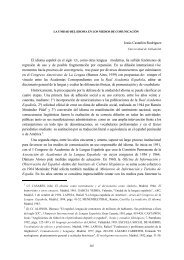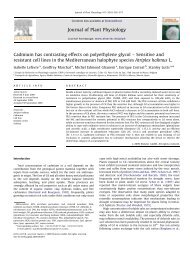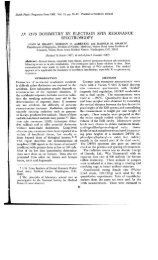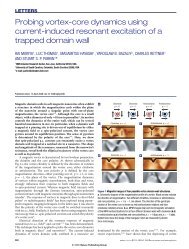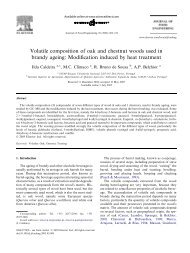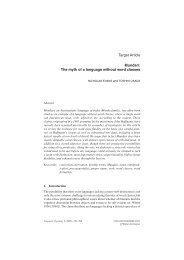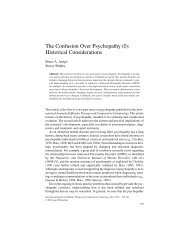Terpenoids: Opportunities for Biosynthesis of Natural Product Drugs ...
Terpenoids: Opportunities for Biosynthesis of Natural Product Drugs ...
Terpenoids: Opportunities for Biosynthesis of Natural Product Drugs ...
Create successful ePaper yourself
Turn your PDF publications into a flip-book with our unique Google optimized e-Paper software.
eviews Ajikumar et al.<br />
to overcome the problem <strong>of</strong> low yield and high costs <strong>for</strong> the<br />
large scale production <strong>of</strong> these valuable compounds has<br />
motivated many to explore this alternative. The microbial<br />
system <strong>of</strong>fers advantages such as (i) environmentally friendly<br />
chemistry, (ii) the use <strong>of</strong> inexpensive carbon sources, (iii)<br />
the capability <strong>of</strong> genetic manipulation to increase production<br />
yields, (iv) compatibility with large scale fermentation<br />
processes due to microbes’ relative insensitivity to shear<br />
stress induced via impeller mixing in bioreactors, (v)<br />
significantly shorter doubling times in microbial systems as<br />
compared to plant cell cultures thereby significantly reducing<br />
culture times and contamination risk while increasing<br />
productivity, (vi) removal from regulation that the pathway<br />
is subject to in the native organism, and (vii) the opportunity<br />
<strong>for</strong> uncoupled growth and production phases <strong>of</strong> the fermentation,<br />
thus allowing optimal media <strong>for</strong>mulations <strong>for</strong> growth<br />
and production.<br />
For the past two decades, terpenoid metabolic engineering<br />
in microorganisms has been focused mostly on carotenoids,<br />
such as lycopene and -carotene, precursors <strong>for</strong> approved<br />
drugs, such as artemisinin and paclitaxel, and a few other<br />
terpenoids molecules. 19,175 Among the numerous carotenoid<br />
compounds, biosynthesis <strong>of</strong> lycopene has been extensively<br />
studied in engineered bacteria. Due to its bright red color,<br />
lycopene is easily detected in bacterial colonies, a property<br />
that has allowed the design <strong>of</strong> engineering strategies <strong>for</strong><br />
screening biodiversity and identifying improvements in<br />
isoprenoid production. 15 Since lycopene is <strong>for</strong>med from the<br />
precursor GGPP, it is possible to screen <strong>for</strong> colonies with<br />
high precursor availability and afterward express the pathways<br />
<strong>for</strong> other terpenoid molecules that use the same<br />
precursor. This introduces the idea <strong>of</strong> a “plat<strong>for</strong>m” strain<br />
that has been engineered to provide large quantities <strong>of</strong> a<br />
precursor. Different product pathways can be added to the<br />
“plat<strong>for</strong>m” strain to provide a variety <strong>of</strong> terpenoids. Two <strong>of</strong><br />
the most utilized microorganisms <strong>for</strong> expressing heterologous<br />
enzymes <strong>for</strong> the synthesis <strong>of</strong> isoprenoids are E. coli and S.<br />
cereVisiae. A detailed account <strong>of</strong> various pathway manipulation<br />
and engineering ef<strong>for</strong>ts <strong>for</strong> terpenoid production in<br />
bacteria and yeast is summarized in Tables 1 and 2.<br />
Metabolic Engineering <strong>of</strong> Terpenoid <strong>Product</strong>ion in<br />
E. coli. In the past 15 years, considerable ef<strong>for</strong>t has focused<br />
on cloning and expression <strong>of</strong> various heterologous genes in<br />
the downstream terpenoid biosynthetic pathways, introducing<br />
a heterologous mevalonate pathway, manipulating the upstream<br />
MEP pathways in E. coli <strong>for</strong> improved precursor<br />
supply through overexpression or deletion <strong>of</strong> upstream<br />
pathway genes, and altering the global metabolic network<br />
through directed changes and mutagenesis libraries. Several<br />
recent reviews cover many <strong>of</strong> these metabolic engineering<br />
approaches <strong>for</strong> the improved production <strong>of</strong> terpenoids in E.<br />
coli. 15,16,19<br />
(175) Das, A.; Yoon, S. H.; Lee, S. H.; Kim, J. Y.; Oh, D. K.; Kim,<br />
S. W. An update on microbial carotenoid production: application<br />
<strong>of</strong> recent metabolic engineering tools. Appl. Microbiol. Biotechnol.<br />
2007, 77, 505–512.<br />
180 MOLECULAR PHARMACEUTICS VOL. 5, NO. 2<br />
Construction <strong>of</strong> Heterologous Biosynthetic Reactions<br />
<strong>for</strong> <strong>Terpenoids</strong>. One <strong>of</strong> the first attempts to clone and<br />
express carotenoid biosynthesis genes in E. coli was carried<br />
out by Misawa et al. in 1990. 176 The carotenoid biosynthetic<br />
genes crtE, crtX, crtY, crtI, crtB, and crtZ were cloned from<br />
a phytopathogenic bacterium, Erwinia uredoVora, into E. coli<br />
and characterized. The genes in this pathway appear to be<br />
closer to those in higher plants than to those in other bacteria.<br />
Also, it is significant that only one gene product (CrtI) is<br />
required <strong>for</strong> the conversion <strong>of</strong> phytoene to lycopene, a<br />
conversion in which four sequential desaturations should<br />
occur via the intermediates phyt<strong>of</strong>luene, zeta-carotene, and<br />
neurosporene. The obtained yields <strong>of</strong> zeaxanthin, -carotene,<br />
and lycopene were approximately 2 mg/g dry cell weight.<br />
The successful production <strong>of</strong> diterpene, taxadiene, the first<br />
intermediate in the biosynthetic pathway <strong>of</strong> paclitaxel, was<br />
achieved in E. coli by the overexpression <strong>of</strong> genes encoding<br />
isopentenyl diphosphate isomerase (idi) (details <strong>of</strong> modifications<br />
to the non-mevalonate pathway will be discussed<br />
below), geranylgeranyl diphosphate synthase and taxadiene<br />
synthase. 177 This demonstration supported the possibility <strong>of</strong><br />
making other valuable terpenes in E. coli. However the<br />
observed yield was very low at 1.3 mg/L. The same group<br />
attempted the biosynthesis <strong>of</strong> the spearmint monoterpene<br />
ketone (-)-carvone in E. coli. 178 Overexpression <strong>of</strong> the<br />
pathway genes geranyl geranyl diphosphate synthase, limonene<br />
synthase, cytochrome P450 limonene hydroxylase,<br />
and carveol dehydrogenase yielded 5 mg/L intermediate (-)limonene.<br />
Assays <strong>of</strong> pathway enzymes and intermediates<br />
indicated that flux through the initial steps catalyzed by<br />
geranyl geranyl diphosphate synthase and limonene synthase<br />
was severely limited by the availability <strong>of</strong> the isoprenoid<br />
precursors. However, by feeding the intermediate precursor<br />
(-)-limonene the functional capability <strong>of</strong> limonene-6-hydroxylase<br />
and carveol dehydrogenase to produce the endproduct<br />
carvone was demonstrated. Un<strong>for</strong>tunately, inefficient<br />
uptake <strong>of</strong> (-)-limonene limited conversion efficiency. The<br />
pathways <strong>for</strong> amorphadiene and 8-hydroxycadinene have also<br />
been successfully expressed in E. coli. 179–181<br />
Modifications to the Non-Mevalonate Pathway. Many<br />
issues arise in the cloning <strong>of</strong> heterologous terpenoid pathways<br />
because <strong>of</strong> limitations in the supply <strong>of</strong> the universal precursors<br />
IPP and DMAPP. Metabolic engineering <strong>of</strong> the non-mevalonate<br />
(176) Misawa, N.; Nakagawa, M.; Kobayashi, K.; Yamano, S.;<br />
Nakamura, K.; Harashima, K. Elucidation <strong>of</strong> the Erwinia<br />
uredovora carotenoid biosynthetic pathway by functional analysis<br />
<strong>of</strong> gene products expressed in Escherichia coli. J. Bacteriol. 1990,<br />
172, 6704–6712.<br />
(177) Huang, Q.; Roessner, C. A.; Croteau, R.; Scott, A. I. Engineering<br />
Escherichia coli <strong>for</strong> the synthesis <strong>of</strong> taxadiene, a key intermediate<br />
in the biosynthesis <strong>of</strong> taxol. Bioorg. Med. Chem. 2001, 9, 2237.<br />
(178) Carter, O. A.; Peters, R. J.; Croteau, R. Monoterpene biosynthesis<br />
pathway construction in Escherichia coli. Phytochemistry 2003,<br />
64 (2), 425–433.<br />
(179) Martin, V. J.; Pitera, D. J.; Withers, S. T.; Newman, J. D.;<br />
Keasling, J. D. Engineering a mevalonate pathway in Escherichia<br />
coli <strong>for</strong> production <strong>of</strong> terpenoids. Nat. Biotechnol. 2003, 21, 796–<br />
802.



